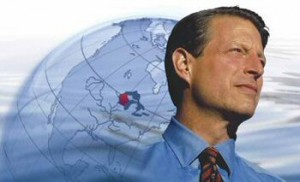
By John Addison (10/12/09). Vice President Al Gore is optimistic about a meaningful agreement in Copenhagen that includes the United States and China. During his keynote speech at the Society of Environmental Journalists Conference in Madison, Wisconsin, he acknowledged that negotiations are going slowly, because climate change is complex and involves consensus of almost all nations, but that a new agreement is likely.
The need for a global agreement is urgent as the burning of coal and oil heat the earth. Melting glaciers and depleted aquifers make healthy water scarce for more Americans and unavailable for a billion people. Draughts are causing damage to many states. Lack of water affects the ability to grow food. Interrelated eco-systems are showing their stress and the problems are starting to get visible on Main Street. Mr. Gore observed, “Never before in human history has a single generation been asked to make such difficult and consequential decisions.”
Mr. Gore stated, “We’re borrowing money from China to buy oil from the Persian Gulf to burn it in ways that destroy the planet. Every bit of that’s got to change.â€
At SEJ, I asked Vice President Gore about the most promising innovations to reduce our dependency on fossil fuels such as coal and oil. Mr. Gore identified a number of areas where Americans are innovating.
Energy efficiency tops his list for innovation that is making an immediate impact. Many new buildings have a fraction of the greenhouse gas emissions of the buildings they replace due to innovative design, materials, windows, and water management. Older buildings are made more energy efficient with better insulation.
Mr. Gore identified wasted heat as an underestimated opportunity. He sees room for significant innovation in combined heat and power and in the reduction of wasted heat.
Super Grid will Spur Innovation
He sees the super grid as an opportunity for a high level of efficiency. The super grid envisions a national network of high capacity electricity transmission. It would include energy storage, high reliability, and smart grid intelligence. High voltage lines have far less energy loss than lower capacity. A super grid could deliver much of America’s needed energy from untapped wind that blows in middle states from the Dakotas to Texas.
Mr. Gore feels that a super grid could bring a transformation comparable to the Internet. The super grid and smart grid technology is already attracting major investments from firms like KPCB where Al Gore devotes part of his time as a partner. KPCB Greentech Portfolio He pointed to energy storage and demand response as major super grid areas of opportunity.
A portfolio of renewable energy solutions can power the nation according to Mr. Gore. Wind supplied 40 percent of the incremental energy added in the United States in 2008. Concentrating solar power is another renewable that is promising where up to 15 hours of energy storage, such as molten salt, can be used. Vice President Gore sees the greatest innovation in solar photovoltaics as a “distributed distribution architecture†is put in place.
Enhanced geothermal at one to two kilometers underground has the potential to meet our need for baseload grid power. Gore said, “There is an estimated 35,000 year supply of enhanced geothermal to meet U.S. energy needs.†This industry will benefit from the drilling and drill bit innovation existing in the oil and gas industries.
Historic Transformation of Automobile
In the future the need for getting baseload power from coal will be diminished by grid energy storage innovation. Gore said, “There will be a historic transformation of automobile fleets to and plug-in hybrids and all-electric vehicles. That vehicle fleet will serve as a massively distributed battery.†Electric Vehicle Reports
He continued, “Innovation of battery storage is likely to be extremely significant.â€
Video of Vice President Gore’s discussion of energy solutions.
New Climate Agreement in Copenhagen
“We have all the tools to solve three or four climate crises.†Vice-President Gore expressed a level of optimism that surprised a number of the 500 journalists in attendance. He is optimistic that the Senate will approve some form of the Boxer-Kerry legislation and that it will be Conference Committee pending when Copenhagen convenes. It will have compromises that will discourage some environmentalists and some business interests. Gore said, “The large number of defections from the National Chamber of Commerce is a sign that business leaders want to be part of the solution.â€
He reminded those concerned about a climate crisis that in 1987 the Montreal Protocol was also criticized as too weak. In Montreal, Canada, on September 16, 1987, the Montreal Protocol on Substances that Deplete the Ozone Layer was signed into agreement by 24 major countries of the world, including the United States. These countries recognized that it was critical to be leaders, rather than wait years for all nations to agree. The agreement was ratified and then signed by President Ronald Reagan.
A process for nations to phase-out production of dangerous CFCs and halons was established. Developing countries were giving extra years to comply. Years later the agreement was strengthened in Copenhagen. Now 191 nations have agreed to the Montreal Protocol and are phasing-out the destructive gases from China to Chile and from India to Indonesia.
The Montreal Protocol is proof that the major nations of the world can agree to stop destroying our atmospheric shield.
A new climate agreement in Copenhagen would accelerate innovation and growing commercial success of efficient buildings, fuel efficient transportation, a transformative super gird, and renewable energy.
Mr. Gore’s new book – Our Choice: A Plan to Solve the Climate Crisis – will be available November 3. It will include the important role of innovation in reducing our dependency on fossil fuel.
The complete audio recording of the speech can be heard on the Society of Environmental Journalists.
